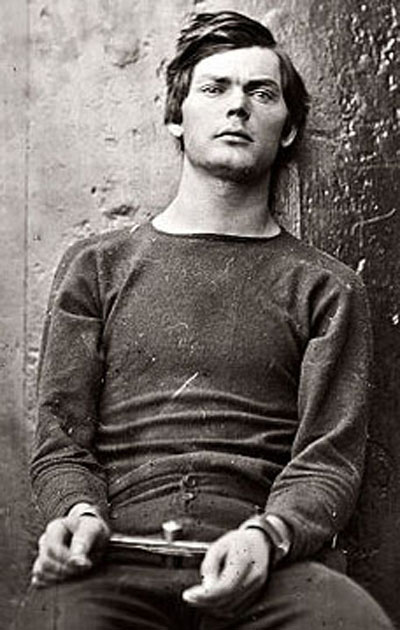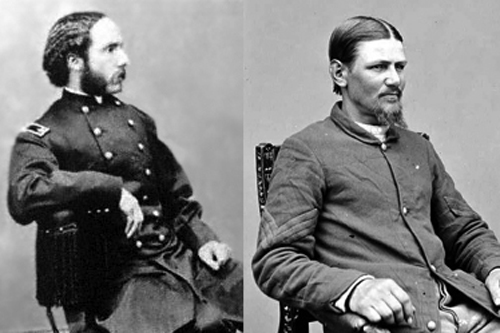John Wilkes Booth’s assassination of President Lincoln was actually one of three elements in the planned attack on April 14, 1865. Booth had learned that Lincoln was to attend the play Our American Cousin at Ford's Theater, and, being a well-known youngest member of a famous acting family, was very familiar with the interior of the building. He scouted out Ford's Theater hours before Lincoln's arrival, and planned his attack meticulously. Booth carved a peephole in the door to the Presidential Box and rigged up a way to jam it shut once he was inside.
Ultimately, Lincoln arrived and he and his wife, Mary, took their seats alongside Major Henry Rathbone and his fiancee Clara. After the play had begun, Lincoln's normal bodyguard, John Parker, had left the area, but his valet Charles Forbes, greeted and spoke briefly with Booth, as they had both recognized each other.
Booth therefore went essentially unopposed into the Box, where he shot the President at about 10:15 at night. Major Rathbone leapt to grab Booth, but the assassin slashed at the Major with a knife, injuring him slightly. Booth then leapt down to the stage, breaking his leg in the process. He shouted his famous cry, "Sic semper tyrannis!" (Literally, "thus always to tyrants!") fled the theater, and escaped on a waiting horse.
Lewis Powell
At the same time that Booth perpetrated the attack on Lincoln in Ford's Theater, his co-conspirator Lewis Powell assaulted the home of Secretary of State William Seward. He bluffed his way past the doorman, but was confronted with Seward's oldest son on the staircase leading up to the bedroom level. Powell raised his pistol and pulled the trigger, but the weapon misfired; in desperation, he clubbed Frederick Seward over the head with it instead. Frederick fell unconscious on the stairs, but Powell's pistol was now out of order entirely. Intent on completing the deed, Powell continued up the stairs as he drew his second weapon: a silver-plated Bowie knife.
Upon reaching the top, he realized that he had no idea which bedroom was Seward's. By chance, the Secretary's daughter, upon hearing the commotion, briefly opened the bedroom door to peek out; Powell saw the door move and immediately sped in that direction. Powell burst into the room where Seward was lying in bed, recovering from an earlier injury, with several other family members and attendants about. Powell charged in, slashing and thrashing about in a frenzy, injuring Seward's daughter, his younger son Augustus, a bodyguard, a messenger, and Seward himself, but none fatally.
Finally, Powell fled, racing down the stairs and out the front door in a bid to make his escape. However, upon reaching the street, he discovered that during the melee, his “getaway driver” had panicked and left with his horse and buggy, so Powell was left to his own devices to find a way out of the city. Powell, an Alabama native unfamiliar with the layout of Washington DC, got hopelessly lost in the streets, where detectives found him several hours later.
The third conspirator, George Atzerodt, was supposed to kill Vice President Andrew Johnson, but lost his nerve and went to get drunk instead.
After escaping the theater, Booth fled south and was eventually cornered in a barn at a Virginia tobacco farm, where soldiers trapped him within a burning burn before one of their number shot him through the slats. As it turns out, both men who attacked John Wilkes Booth ended up going insane. Major Rathbone (left), President Lincoln’s guest in the Presidential Box of Ford’s Theater, and who had grabbed at Booth after the shooting, later moved to Germany, where he killed his wife and attempted to kill his sons and himself; he was eventually committed to an asylum there. Boston Corbett (right), the soldier who fatally shot Booth in the Virginia farm, was committed to the Topeka (Kansas) Asylum; as Corbett was a milliner, mercury poisoning—a problem in hat-making in those days, and source of the phrase “mad as a hatter”—was likely the cause of his problems.
Abraham Lincoln's hearse
Links and Sources:
"Lincoln Assassinated!" by Prof. Donald E. Wilkes, Jr., in Flagpole Magazine, April 20, 2005.
Manhunt: The 12-Day Chase for Lincoln's Killer, by James Swanson, Harper Collins, 2006.
Blood on the Moon: The Assassination of Abraham Lincoln, by Edward Steers, University Press of Kentucky, 2001.
Image of Lewis Powell was taken by Alexander Gardner on board the US monitor Saugus, shortly after his capture in 1865, and is from the Library of Congress.
Image of assassination from Granger Art on Demand.
Image of Henry Rathbone courtesy of the Lincoln Museum, Fort Wayne, Indiana
Image of Boston Corbett from www.old-picture.com.
"Lincoln's Last Night" © 2015 by James Husband




